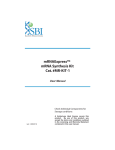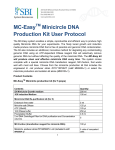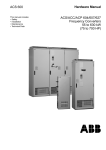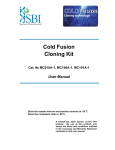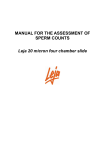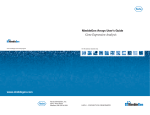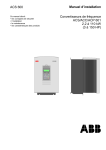Download MetaMorph Mutagenesis Kit
Transcript
MetaMorph Mutagenesis Kit MetaMorph Mutagenesis Kit Cat. #MC200 Series User Manual Store competent cells at -80ºC Store enzymes at -20ºC ver. 1-110110 A limited-use label license covers this product. By use of this product, you accept the terms and conditions outlined in the Licensing and Warranty Statement contained in this user manual. MetaMorph Mutagenesis Kit™ Cat. # MC200 Series Contents I. Introduction .............................................................................2 A. Key Features .......................................................................2 B. List of Components .............................................................3 C. Storage................................................................................3 D. Other Needed Reagents .....................................................4 E. Overview of Protocol ...........................................................4 F. One-day Protocol ................................................................5 II. Protocols .................................................................................5 A. Primer Design .....................................................................5 B. PCR Reactions and Vector Linearization ...........................8 C. MetaMorph Reactions .......................................................13 D. Transformation ..................................................................14 III. Examples ..........................................................................15 A. Positive Contol for Insertions ................................................15 B. Positive Control for Multiple Mutations .................................18 C. Example Deletion Mutation ...................................................21 D. Sample Mutagenesis Results ...............................................22 IV. Troubleshooting ................................................................23 V. Technical Support .................................................................25 VI. Licensing and Warranty ....................................................26 888-266-5066 (Toll Free) 650-968-2200 (outside US) Page 1 System Biosciences (SBI) I. User Manual Introduction The MetaMorph Mutagenesis Kit is a simple, rapid and highly efficient PCR-based mutagenesis kit. It allows you to create single and multiple point mutations, deletions or insertions using an easy one-day protocol. Mutagenic PCR fragments are generated with a high fidelity DNA polymerase, mutagenic primers, and vector primers. The mutagenic primers are designed to incorporate the mutation, insertion or deletion. Vector primers are designed to have 20bp homology to the linearized vector ends. The mutagenic PCR fragments fuse to create the final mutated gene-of-interest. The kit is so robust that multiple mutagenic DNA fragments can be assembled simultaneously and cloned into one construct in a single step. The system is highly efficient, with more than 90% efficiency for single mutations, without unwanted mutations being introduced. A. Key Features • • • • • • • • Effective for both single and multiple mutation sites Introduce point mutations, deletions, or insertions Complete mutagenesis within one day Only one transformation step required May be used with any vector Methylation-independent Compatible with all strains of competent E. coli cells Unwanted additional mutations are minimized Page 2 ver. 1-0110110 www.systembio.com MetaMorph Mutagenesis Kit™ Cat. # MC200 Series B. List of Components Kit Component 10 Reactions High Fidelity DNA Polymerase 5 µl 5x PCR Buffer 100 µl Control primer 1 (10 µM) 25 µl Control Primer 2 (10 µM) 25 µl Control Primer 3 (10 µM) 25 µl Control Primer 4 (10 µM) 25 µl Control Primer 5 (10 µM) 25 µl Control Primer 6 (10 µM) 25 µl Control Plasmid (0.5 mg/ml) 10 µl dNTP mix (10mM) 10 µl 5x MetaMorph Solution 20 µl Competent Cells 10 vials C. Storage -80°C for competent cells -20°C for the enzyme 888-266-5066 (Toll Free) 650-968-2200 (outside US) Page 3 System Biosciences (SBI) User Manual D. Other Needed Reagents • • • • • • Gene-specific primers DMSO QIAquick PCR Purification Kit (Cat # 28106, Qiagen) QIAquick Gel Extraction kit (Cat # 28704, Qiagen) SOC or LB Broth for transformation of bacteria LB + Antibiotic plates (depending upon your specific plasmid) E. Overview of Protocol Page 4 ver. 1-0110110 www.systembio.com MetaMorph Mutagenesis Kit™ Cat. # MC200 Series F. One-day Protocol 9:00 am – 1:00 pm PCR Amplification of mutations and restriction digest of vector 1:00 – 2:00 pm Run gel, gel purify PCR products and linearized vector 2:00 – 2:30 pm Reaction Incubation 2:30 – 4:00 pm Transformation II. Protocols A. Primer Design 1. Generating Single Point Mutations or Insertion Mutations Forward and Reverse Vector Primer Design The forward vector primer (in red) should be generated to the positive strand of DNA, and should contain ~20 bases corresponding to the vector sequence leading up to the restriction site where the gene-of-interest has been inserted. The reverse vector primer (in blue) should be generated to the negative strand of DNA, and should also contain ~20 bases complimentary to the vector sequence leading up to the restriction site where the gene-of-interest has been inserted. 888-266-5066 (Toll Free) 650-968-2200 (outside US) Page 5 System Biosciences (SBI) User Manual Mutagenic Primers The reverse mutagenic primer (in red) should be generated to the negative strand of DNA, and should contain 10 bases 5’ of the mutation, the mutagenic bases, and then 20 bases 3’ of the mutation site. The forward mutagenic primer (in blue) should be generated to the positive strand of DNA, and should contain 10 bases 5’ of the mutation, the mutagenic or inserted bases, and then 20 bases 3’ of the mutation site. The forward and reverse mutagenic primers, therefore have a region of ~20 bases that is entirely complimentary and that contains the mutagenic bases. Melting Temperature of Primers for Point Mutations and Insertion Mutations The Tm for primers for point mutations and insertion mutations should be calculated using only the 20 bases that are 3’ of the mutagenic site. The mutagenic base(s) and the 10 bp that are 5’ of the mutation site should not be included in the calculation for Tm. 2. Generating Deletion Mutations Forward and Reverse Vector Primer Design The forward vector primer (in red) should be generated to the positive strand of DNA, and should contain ~20 bases corresponding to the vector sequence leading up to the restriction site where the gene-of-interest has been inserted. The reverse vector primer (in blue) should be generated to the negative strand of DNA, and should also contain ~20 bases complimentary to the vector sequence leading up to the restriction site where the gene-of-interest has been inserted. Page 6 ver. 1-0110110 www.systembio.com MetaMorph Mutagenesis Kit™ Cat. # MC200 Series Mutagenic Primers The reverse mutagenic primer (in red) should be generated to the negative strand of DNA, and should contain 10 bases 5’ of the mutation, (remove the bases you wish to delete), and then 20 bases 3’ of the mutation site. The forward mutagenic primer (in blue) should be generated to the positive strand of DNA, and should contain 10 bases 5’ of the mutation, (remove the bases you wish to delete), and then 20 bases 3’ of the mutation site. The forward and reverse mutagenic primers, therefore have a region of ~20 bases that is entirely complimentary and do not contain the bases intended for deletion. Melting Temperature for Deletion Mutation Primers The Tm of the primers for deletion mutations should be calculated using the 20 base pairs of homology in the 3’ region. The 10 base pairs that are homologous to the 5’ region will not affect the Tm. 3. Generating Multiple Mutations Forward and Reverse Vector Primer Design The forward vector primer (in red) should be generated to the positive strand of DNA, and should contain ~20 bases corresponding to the vector sequence leading up to the restriction site where the gene-of-interest has been inserted. The reverse vector primer (in green) should be generated to the negative strand of DNA, and should also contain ~20 bases complimentary to the vector sequence leading up to the restriction site where the gene-of-interest has been inserted. 888-266-5066 (Toll Free) 650-968-2200 (outside US) Page 7 System Biosciences (SBI) User Manual Mutagenic Primers The reverse mutagenic primer #1 (in red) should be generated to the negative strand of DNA, and should contain 10 bases 5’ of the mutation, the mutation (base substitution or deletion), and then 20 bases 3’ of the mutation site. The forward mutagenic primer #1 (in blue) should be generated to the positive strand of DNA, and should contain 10 bases 5’ of the mutation, the mutation (base substitution or deletion), and then 20 bases 3’ of the mutation site. The reverse mutagenic primer #2 (in blue) should be generated to the negative strand of DNA, and should contain 10 bases 5’ of the second mutation, the mutation (base substitution or deletion), and then 20 bases 3’ of the second mutation. The forward mutagenic primer #2 (in green) should be generated to the positive strand of DNA, and should contain 10 bases 5’ of the second mutation, the mutation (base substitution or deletion), and then 20 bases 3’ of the second mutation. The sets forward and reverse mutagenic primers, therefore have a region of ~20 bases that is entirely complimentary and contain the desired, respective mutations. B. PCR Reactions and Vector Linearization 1. Single Point, Insertion, and Deletion Mutations In a single mutation reaction, 2 PCR reactions must be set up. You can set them up and run them simultaneously. Page 8 ver. 1-0110110 www.systembio.com MetaMorph Mutagenesis Kit™ Cat. # MC200 Series PCR Reaction A This reaction should contain the forward vector primer, and the reverse mutagenic primer, in addition to the template DNA and other required reagents for the PCR reaction. PCR Reaction B This reaction should contain the forward mutagenic primer and the reverse vector primer, in addition to the template DNA and other required reagents for the PCR reaction. The resulting PCR reactions create 2 fragments of the mutated gene of interest. One is a 5’ region of the mutated gene; the other is a 3’ region of the mutated gene. The fragments have approximately 20 base pairs of overlap. 2. Multiple Mutations In a multiple mutation reaction, the number of PCR reactions equals one more than the number of mutations (R= n+1). For example, if you are designing a construct with 2 mutations, R=2 +1 = 3 PCR reactions must be set up. If you are designing a construct with 3 mutations, 4 PCR reactions must be set up. These can be set up and run simultaneously. Each reaction should contain a forward primer (either the forward vector primer, or mutagenic primer), and a corresponding reverse primer (either the reverse vector or mutagenic primer). 888-266-5066 (Toll Free) 650-968-2200 (outside US) Page 9 System Biosciences (SBI) User Manual The resulting PCR reactions create n+1 fragments of the mutated gene of interest. The most 5’ reaction contains the 5’ region of the mutated gene; the last reaction contains a 3’ region of the mutated gene. Each fragment has approximately 20 base pairs of overlap with the neighboring fragment. 3. Other Information about PCR Conditions • When using the MetaMorph Mutagenesis Kit for the first time, we strongly recommend that you perform the positive control reactions in parallel with your experimental samples. The PCR reactions and conditions for the positive controls can be found in Section III of this manual. • The PCR fragments for the mutated cDNA-of-interest should be generated with the high fidelity DNA polymerase that is included in the kit. Use of a substituted DNA polymerase will decrease the efficiency of the MetaMorph Mutagenesis kit. • Specific PCR reaction conditions should be optimized for the cDNA-of-interest. Page 10 ver. 1-0110110 www.systembio.com MetaMorph Mutagenesis Kit™ Cat. # MC200 Series Recommended PCR conditions for a 50 µl reaction Component H2O Volume Add to 50 µl 5x PCR Buffer 10 µl dNTPs (10 mM) 1 µl Primer A (10 µM) x µl Primer B (10 µM) x µl Template DNA x µl DMSO 1.5 µl High Fidelity DNA polymerase (from kit) 0.5 µl Recommended PCR Program Cycle Step Temperature Time Cycles Initial denaturation 98°C 3 min 1 Denaturation 98°C 30s 30 Annealing - -°C* 10-30s Extension Final Extension 72°C 15-30s /kb 72°C 10 min 4°C Hold 1 *For primers with >20nt, anneal for 10-30s at 3°C plus the Tm of lower primer. For primers≤ 20nt, use an annealing temperature equal to the Tm of the lower primer. 888-266-5066 (Toll Free) 650-968-2200 (outside US) Page 11 System Biosciences (SBI) • User Manual After completion of the PCR reaction, gel purify the appropriate band to remove any extra primers or primer dimmers that will inhibit the reaction. We recommend the QIAquick PCR Purification Kit (Cat # 28106, Qiagen). 4. Linearize the Vector While the PCR reactions are running, the vector containing the wild-type gene-of-interest should be linearized with restriction enzyme(s) to release the gene-of-interest and should then be gel purified. We recommend using 2 µg of plasmid in a 50 µl reaction volume for the restriction digest. Page 12 ver. 1-0110110 www.systembio.com MetaMorph Mutagenesis Kit™ Cat. # MC200 Series C. MetaMorph Reactions Set up the following reactions in a 1.5 ml sterile reaction tube by mixing the following reagents gently. Spin down briefly to collect the reagents at the bottom of the tube. 1. Mutagenesis Reaction Linearized destination vector (10-100ng/µl) PCR insert(s) (20-200ng/µl) (for each PCR Product) dH2O 5x MetaMorph Solution total 1µl* 1µl* _µl 2µl 10µl 2. Negative Control Control vector (2ug) cut with Nde1+BamH1 dH2O 5x MetaMorph Solution total 1µl* 7µl 2µl 10µl * A 2:1 or 1:1 molar ratio of insert: vector works well in the MetaMorph reaction. For reactions with larger volumes of vector and insert (>8µl of vector + insert), double the amount of reaction buffer and enzyme, and add dH20 for a total volume of 20µl. When using the MetaMorph Mutagenesis Kit for the first time, we strongly recommend that you perform the positive and negative control reactions in parallel with your experimental samples. The specific reaction conditions are found in Section III of this manual. 3. MetaMorph Reaction Incubation 1. 10 minutes at room temperature 2. 10 minutes one ice 888-266-5066 (Toll Free) 650-968-2200 (outside US) Page 13 System Biosciences (SBI) User Manual D. Transformation 1. 2. 3. 4. 5. 6. 7. Add 50µl competent cells to the cloning mixture Incubate on ice for 20 minutes Heat shock at 42˚C for 50 seconds Transfer on ice for 2 minutes Add 250µl S.O.C medium or LB broth Incubate at 37˚C for an hour Take 100µl culture spread on pre-warmed (37˚C) culture plate containing the appropriate antibiotic for your plasmid. 8. Incubate the plate at 37˚C overnight. Page 14 ver. 1-0110110 www.systembio.com MetaMorph Mutagenesis Kit™ III. Cat. # MC200 Series Examples A. Positive Contol for Insertions 888-266-5066 (Toll Free) 650-968-2200 (outside US) Page 15 System Biosciences (SBI) User Manual PCR Reactions Single Mutations (insertion) PCR Reaction A H2O 32 µl 5x PCR Buffer 10mM dNTPs Primer 1 (10mM) Primer 2 (10mM) Template DNA DMSO High Fidelity DNA polymerase 10 µl 1 µl 2.5 µl 2.5 µl 0.2 µl 1.5 µl 0.5 µl PCR Reaction B H2O 32 µl 5x PCR Buffer 10mM dNTPs Primer 3 (10mM) Primer 4 (10mM) Template DNA DMSO High Fidelity DNA polymerase 10 µl 1 µl 2.5 µl 2.5 µl 0.2 µl 1.5 µl 0.5 µl Page 16 ver. 1-0110110 www.systembio.com MetaMorph Mutagenesis Kit™ Cat. # MC200 Series PCR Conditions Single Mutations (insertion) Cycle Step Temperature Time Cycles Initial denaturation 98°C 3 min 1 Denaturation 98°C 30s Annealing Extension 30s 55°C 20s 30 72°C Final Extension 10 min 72°C Hold 1 4°C Linearize the Control Vector H2O 40 µl 10x Buffer 2 Control vector (0.5ug/ul) Nde 1 BamH1 5 µl 4 µl 0.5 µl 0.5 µl Positive control MetaMorph reaction for single mutations Control vector cut with Nde1+BamH1 1 µl PCR mutation fragment A 1 µl PCR mutation fragmentB 1 µl dH2O 5 µl 5x MetaMorph Solution 2 µl Total 10 µl 888-266-5066 (Toll Free) 650-968-2200 (outside US) Page 17 System Biosciences (SBI) User Manual B. Positive Control for Multiple Mutations Page 18 ver. 1-0110110 www.systembio.com MetaMorph Mutagenesis Kit™ Cat. # MC200 Series PCR Reactions for Multiple Mutations PCR Reaction A H2O 32 µl 5x PCR Buffer 10mM dNTPs Primer 1 (10mM) Primer 5 (10mM) Template DNA DMSO High Fidelity DNA polymerase 10 µl 1 µl 2.5 µl 2.5 µl 0.2 µl 1.5 µl 0.5 µl PCR Reaction B H2O 32 µl 5x PCR Buffer 10mM dNTPs Primer 6 (10mM) Primer 2 (10mM) Template DNA DMSO High Fidelity DNA polymerase 10 µl 1 µl 2.5 µl 2.5 µl 0.2 µl 1.5 µl 0.5 µl PCR Reaction C H2O 5x PCR Buffer 10mM dNTPs Primer 3 (10mM) Primer 4 (10mM) Template DNA DMSO High Fidelity DNA polymerase 32 µl 10 µl 1 µl 2.5 µl 2.5 µl 0.2 µl 1.5 µl 0.5 µl 888-266-5066 (Toll Free) 650-968-2200 (outside US) Page 19 System Biosciences (SBI) User Manual PCR Conditions for Multiple Mutations Cycle Step Temperature Time Cycles Initial denaturation 98°C 3 min 1 Denaturation 98°C 30s Annealing Extension 30s 55°C 20s 30 72°C Final Extension 10 min 72°C Hold 1 4°C Linearize the control vector H2O 40 µl 10x Buffer 2 Control vector (0.5ug/ul) Nde 1 BamH1 5 µl 4 µl 0.5 µl 0.5 µl Positive control MetaMorph reaction for multiple mutations Control vector (2ug) cut with Nde1+BamH1 1 µl PCR mutation fragment A 1 µl PCR mutation fragment B 1 µl PCR mutation fragment C 1 µl dH2O 4 µl 5x MetaMorph Solution 2 µl total 10 µl Page 20 ver. 1-0110110 www.systembio.com MetaMorph Mutagenesis Kit™ Cat. # MC200 Series C. Example Deletion Mutation (No positive control for deletions included in the MetaMorph kit) 888-266-5066 (Toll Free) 650-968-2200 (outside US) Page 21 System Biosciences (SBI) User Manual D. Sample Mutagenesis Results The yellow arrows indicate the bands that need to be extracted from the gel. The PCR fragments are then combined with the cut vector and the 5x MetaMorph Solution to create the finished mutagenic construct. The construct is then transformed into any kind of competent E. coli strain. More than 90% of the clones will contain the mutation. Page 22 ver. 1-0110110 www.systembio.com MetaMorph Mutagenesis Kit™ IV. Cat. # MC200 Series Troubleshooting Problem Probable cause Solution Primer sequences are incorrect Check primer sequences to ensure that they follow the rules of primer design as described in the manual. Suboptimal PCR product 1. No or few colonies obtained from the transformation Optimize your PCR amplification reactions so that you generate pure PCR products. Use a different method to purify your PCR product. Low DNA concentration in reaction It is imperative to obtain as high a DNA concentration as possible in your reaction. Inhibitory contaminants from PCR product or linearized vector Both the PCR products and the linearized vector should be purified. Transform with too much reaction mixture Do not add more than 10µl of reaction mixture to 50µl of competent cells. Too much reaction mixture inhibits the transformation. 888-266-5066 (Toll Free) 650-968-2200 (outside US) Page 23 System Biosciences (SBI) Problem User Manual Probable cause Solution Handle competent cells gently. Do not re-freeze cells after thawing. Low quality or poor handling of competent cells 2. Large numbers of colonies contain no insert Page 24 Quality of competent cells may be tested by transforming a circular plasmid to determine cells’ competency. Competent cells with a transformation efficiency of ≥ 1x109 cfu/ μg are recommended. Wrong antibiotic or too much antibiotic in the media Choose plates with the appropriate concentration of the right antibiotic. Incomplete linearization of your vector It is critical to remove any uncut vector prior to use in the MetaMorph reaction. If necessary, re-digest your vector and gel purify. Contamination of cloning reaction with plasmid with the same antibiotic resistance If you insert was amplified from a plasmid, circular DNA may have carried through purification and contaminated the cloning reaction. We recommended gel purifying your PCR product or linearizing the template DNA before performing PCR. ver. 1-0110110 www.systembio.com MetaMorph Mutagenesis Kit™ Cat. # MC200 Series Problem Probable cause Solution 2. Large numbers of colonies contain no insert Plates are too old or contained incorrect antibiotic Make sure that your antibiotic plates are fresh. Check the antibiotic resistance of your fragment. 3. Clones contain incorrect insert PCR products contain nonspecifically amplified artifacts Optimize your PCR reaction to improve the specificity. Screen more colonies for the correct clones. V. Technical Support For more information about SBI products and to download manuals in PDF format, please visit our web site: http://www.systembio.com For additional information or technical assistance, please call or email us at: Phone: (650) 968-2200 (888) 266-5066 (Toll Free) Fax: (650) 968-2277 E-mail: General Information: [email protected] Technical Support: [email protected] Ordering Information: [email protected] System Biosciences (SBI) 1616 North Shoreline Blvd. Mountain View, CA 94043 888-266-5066 (Toll Free) 650-968-2200 (outside US) Page 25 System Biosciences (SBI) VI. User Manual Licensing and Warranty Limited Use License Use of the MetaMorph Mutagenesis Kit (i.e., the “Product”) is subject to the following terms and conditions. If the terms and conditions are not acceptable, return all components of the Product to System Biosciences (SBI) within 7 calendar days. Purchase and use of any part of the Product constitutes acceptance of the above terms. Purchase of the product does not grant any rights or license for use other than those explicitly listed in this Licensing and Warranty Statement. Use of the Product for any use other than described expressly herein may be covered by patents or subject to rights other than those mentioned. SBI disclaims any and all responsibility for injury or damage which may be caused by the failure of the buyer or any other person to use the Product in accordance with the terms and conditions outlined herein. SBI has pending patent applications related to the Product. For information concerning licenses for commercial use, contact SBI. Limited Warranty SBI warrants that the Product meets the specifications described in the accompanying Product Analysis Certificate. If it is proven to the satisfaction of SBI that the Product fails to meet these specifications, SBI will replace the Product or provide the purchaser with a refund. This limited warranty shall not extend to anyone other than the original purchaser of the Product. Notice of nonconforming products must be made to SBI within 30 days of receipt of the Product. SBI’s liability is expressly limited to replacement of Product or a refund limited to the actual purchase price. SBI’s liability does not extend to any damages arising from use or improper use of the Product, or losses associated with the use of additional materials or reagents. This limited warranty is the sole and exclusive warranty. SBI does not provide any other warranties of any kind, expressed or implied, including the merchantability or fitness of the Product for a particular purpose. Page 26 ver. 1-0110110 www.systembio.com MetaMorph Mutagenesis Kit™ Cat. # MC200 Series SBI is committed to providing our customers with high-quality products. If you should have any questions or concerns about any SBI products, please contact us at (888) 266-5066. © 2010 System Biosciences (SBI), All Rights Reserved. 888-266-5066 (Toll Free) 650-968-2200 (outside US) Page 27




























